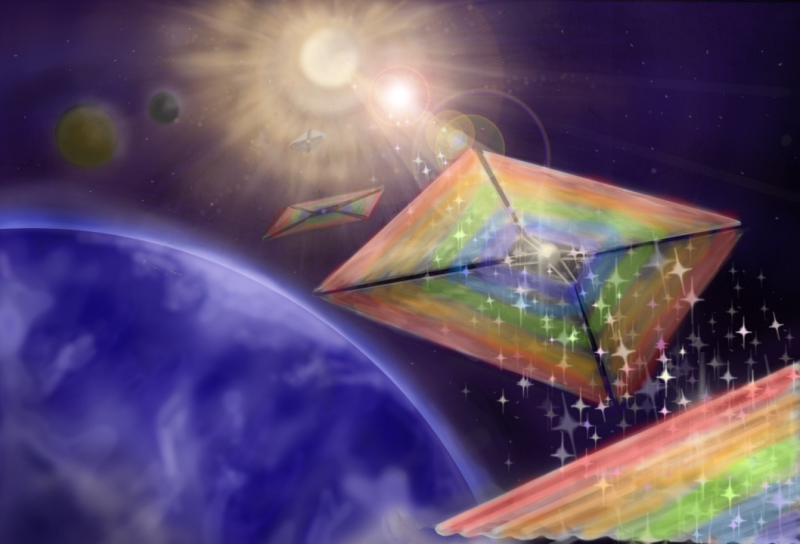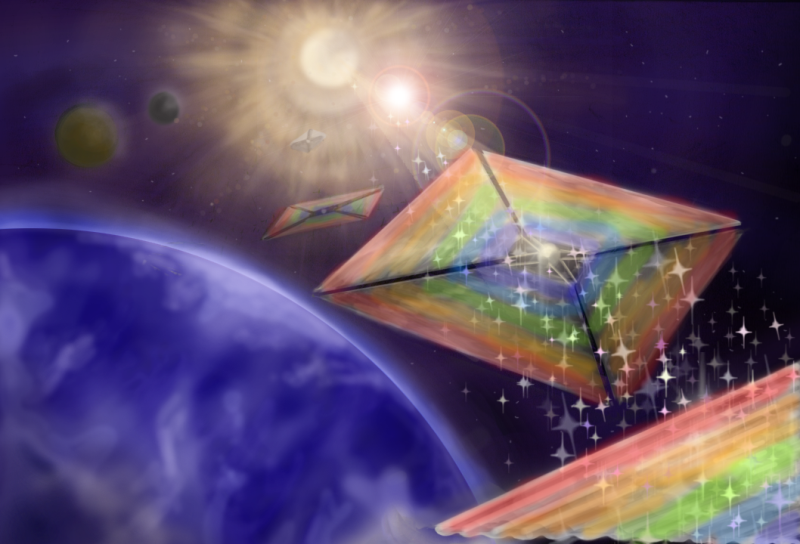New Spaceship Sail Self-Centers
To snap close-up photos of planets outside our Solar System (exoplanets), some researchers are proposing the use of a fleet of “light sails” propelled by powerful Earth-bound lasers. A new experiment has demonstrated a possible sail design that uses diffraction gratings, rather than the reflective mirrors that have been used in previous sail designs. The gratings deflect an incoming laser beam at an angle, creating a sideways force that keeps the sail aligned with the beam’s center. Further testing is needed, but the team developing the sail is hopeful that their “beam-rider” technology could guide probes to faraway stars or to closer targets in our own Solar System.
Chemically powered rockets continue to be the dominant form of space travel. However, venturing out of the Solar System will require more energy than chemical fuel propellants can supply. “Rockets have done just as much as they can do,” says Grover Swartzlander from Rochester Institute of Technology in New York. Light sails are one alternative, with the earliest proposals dating from the 19th century. The simplest idea is to deploy a large mirror that reflects sunlight. With such a sail, the force providing propulsion is small compared with that of conventional rockets, but the available energy is limitless.
Both the Japanese space agency and NASA have flown light sail missions, and the privately funded Planetary Society is currently operating a light sail in orbit around Earth. “The technology is advancing,” Swartzlander says. In 2016, the Breakthrough Starshot project, which was founded by the late physicist Stephen Hawking and billionaires Yuri Milner and Mark Zuckerberg, announced a plan to send 1000 light sails carrying postage-stamp-sized cameras to Proxima b, the closest known exoplanet. To reach their target in 20 years, the sails would be accelerated to 20% of the speed of light by an array of lasers on Earth supplying 100 gigawatts of total power.
Laser-based propulsion can achieve much greater acceleration than solar-based propulsion, but one concern is that the sail can drift out of alignment with the laser beam. Swartzlander’s team has come up with a way to maintain alignment using diffraction gratings. Rather than reflect the laser light, their sail transmits the light at an angle. The deflected light exerts both a forward force to propel the sail and a sideways force to keep it aligned.
To demonstrate this alignment capability, the team built a centimeter-wide sail consisting of two gratings side-by-side. Each grating was made up of nematic liquid crystals contained in a plastic sheet and arranged in a periodic pattern. The pattern on the left side deflected light to the right, whereas the right-side pattern deflected light to the left. The researchers placed the sail in a sensitive force-measuring setup and aimed a laser beam at the center of the sail. Any left- or right-shift of the sail resulted in a nanonewton-scale re-centering force that moved the sail back into alignment with the beam.
Swartzlander says that liquid-crystal gratings are simpler and more cost-effective than other sail-centering solutions, such as nanofabricated metamaterials that would be prohibitively expensive to produce at the large scale needed for a light sail. Using liquid crystals also has the advantage that the grating pattern can be changed with an electrical signal, so that with future designs, one could potentially steer a light sail, just as a pilot steers an airplane. This control could work even when the light source is sunlight rather than a laser beam. Swartzlander imagines using a diffractive light sail on a mission to the Sun or an asteroid. However, he is proposing that the technology first be tested on the International Space Station or on a small satellite in Earth orbit.
Keeping the sail aligned is “a critical step” toward making laser-driven sails practical, says Les Johnson from NASA Marshall Space Flight Center in Alabama. He is leading a NASA-sponsored feasibility study of Swartzlander’s light sail project, but he was not involved in this specific experiment. Johnson says that there are still many questions, such as whether the technology can work in more than one direction (up-down in addition to left-right, for example) and whether these materials can survive high laser intensities. Space scientist Bruce Betts from the Planetary Society agrees that this technology is still in its infancy. “Diffractive sails are not the next steps in space for the young field of space sail propulsion,” he says. “But if proven out and demonstrated [in space], diffractive sails may someday represent a revolutionary leap forward in sail propulsion.”
This research is published in Physical Review Letters.
–Michael Schirber
Michael Schirber is a Corresponding Editor for Physics Magazine based in Lyon, France.
More Information
Japanese light sail mission: IKAROS
NASA light sail mission: NanoSail-D
The Planetary Society light sail mission: LightSail





